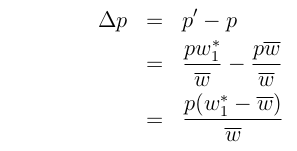 :
:
Recall Mean Population Fitness, denoted  :
:

Though we are considering selection acting on genotypes, we can calculate the
average fitness of each allele (called the Marginal fitness) by multiplying the
probability that an allele finds itself in a particular genotype by the fitness of that
genotype.
We denote marginal fitness by w*, so the marginal fitness of the A1 allele
is:
| Marginal fitness of A1 | = | P[paired with another A1] | * | (fitness if paired with another A1) | + | P[paired with an A2] | * | (fitness if paired with another A1) |
| || | || | || | || | || | ||||
| w1* | = | p | * | w11 | + | (1-p) | * | w12 |
The corresponding calculation yields the marginal fitness of A2. We thus have:

We can also write mean population fitness in terms of the marginal fitnesses of alleles:
 [1]
[1]
Finding the change in allele frequency (p = freq of the A1 allele).
Define p' as the frequency of A1 in the next generation.

Cancelling the 2N terms, we get:

We are most interested in the change in the frequency of the allele over a generation,
denoted  p
p

Substituting from equation [1] for the  in the numerator yields (skipping a couple of simple steps):
in the numerator yields (skipping a couple of simple steps):
 [2]
[2]
This is a very general equation. It holds even if we discard assumptions like random mating. In such cases, we would calculate the marginal fitness values differently, but this exact same equation would follow once they were calculated.
We now consider a special case: Frequency independent selection.
This just means that the genotypic fitness values (w11, w12, and w22) are not functions of the allele frequency, so we can treat them as constants.
In this case, we find the derivative of mean population fitness with respect to p to be:

Or, rearranging:

Substituting this into our equation [2] above yields:

This shows that, under the assumptions that we made (frequency independent
selection on one locus), selection moves the population upward on a "landscape"
defined by  .
.
Selection favoring heterozygote = Balancing Selection
Example: w11 = .2, w12 = 1, w22 =
.2
Selection maintains both alleles in the population, since whenever
one gets rare, selection pushes the population back towards intermediate
frequencies.
In this case, selection counteracts drift by maintaining genetic variation.
Example: Sickle-Cell Disease
Results from a single base substitution in the beta-hemoglobin gene.
GAA mutates to GTA
This converts a Glutamic Acid in the hemoglobin to a Valine.
(This is one mutation that leads to sickle-cell disease, others have arisen in other areas)>
As a result, the hemoglobin molecules bond together forming large structures that distort the cell (hence the name).
Such cells are removed from the system, resulting in severe anemia.
Heterozygotes have only slight anemia BUT, they are somewhat protected
against Malaria.
When the Malaria Parasite (Plasmodium) enters a red blood cell
that is heterozygous for the sickle-cell allele, it causes the cell to
sickle and be removed from the blood stream. Thus preventing infection.
The plot of mean population fitness vs. allele frequency for the sickle-cell allele looks like this (data from Camaroon)
The peak of the function is near p = 0.11, which is the frequency of the sickle-cell allele in this population.
A similar process maintains the allele for G6PD deficiency in populations around the Mediterranean (where Malaria is also prevalent).
Selection favoring a dominant allele
Example: w11 = 1, w12 = 1, w22 =
.2
In this case, selection gets very weak as the allele approaches fixation.
------------------------------------------------------
Homework problem
Plot mean poopulation fitness as a function of p for the following genotypic fitness values:
w11 = 0.2
w12 = 0.2
w22 = 1
Identify where selection will drive the population.
------------------------------------------------------
Selection against a heterozygote
Example: w11 = 1, w12 = .2, w22 =
.9
Here, where the population ends up depends on where it starts out.
There is an unstable equilibrium at intermediate frequencies.
Note that the population may be "stuck" on a lower peak. Jul 8, 2021